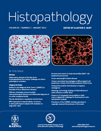Presence of cytogenetic abnormalities in Spitz naevi: a diagnostic challenge for fluorescence in-situ hybridization analysis
Abstract
Martin V, Banfi S, Bordoni A, Leoni-Parvex S & Mazzucchelli L (2012) Histopathology 60, 336–346 Presence of cytogenetic abnormalities in Spitz naevi: a diagnostic challenge for fluorescence in-situ hybridization analysis
Aims: Spitz naevi are difficult to diagnose, because of significant overlap with melanomas. It has been recently demonstrated that the LSI RREB1(6p25)/LSI MYB(6q23)/LSI CCND1(11q13)/CEP6 fluorescence in-situ hybridization (FISH) assay is a reliable tool with which to distinguish benign naevi and melanomas. Little is known about its diagnostic usefulness in Spitz naevi.
Methods and results: We investigated 51 patients with Spitz naevi and long-term median follow-up (8.18 years) with the multicolour FISH probe. Control groups included 11 benign naevi and 14 melanomas. Spitz naevi from 32 (63%) patients did not show cytogenetic abnormalities (FISH−). In contrast, Spitz naevi from 19 (37%) patients showed changes in the investigated loci (FISH+). Spitz naevi with the FISH+ profile showed chromosome X polysomy in 14/18 (78%) patients. All Spitz naevi with the FISH− profile were disomic. All melanomas displayed a FISH+ profile, and 4/11 (36%) showed chromosome X polysomy. No differences in clinicopathological features were detected between Spitz naevi with and without genetic abnormalities.
Conclusions: The presence of gene copy number changes in Spitz naevi as detected by FISH is higher than expected, and Spitz naevi at the genetic level represent a heterogeneous group. The findings of similar cytogenetic alterations in Spitz naevi and melanomas suggest that there should be cautious interpretation of FISH analysis in this setting.




